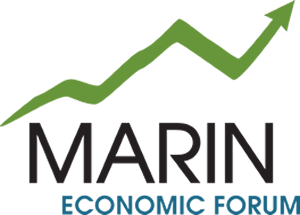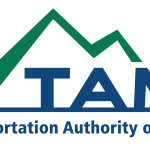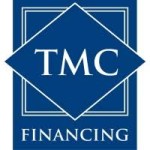Marin County can be ‘economic hub’ for California, economist says
North Bay Business Journal
By Gary Quakenbush

SSU Economic Outlook Conference in Rohnert Park on March 2, 2018 (Photo by Anthony Borders/NBBJ)
With national and California economies good, economist Robert Eyler, Ph.D., is positive about continued expansion — perhaps through 2021 — and believes Marin County will not recess without a national and state recession coming first.
“There are two major economy drivers in Marin — biosciences/biotech research linked to health and wellness, along with tourism, hospitality, food and beverage categories,” said the chief economist for Marin Economic Forum. He’s also dean of the School of Extended and International Education senior international officer and professor of economics at Sonoma State University. “These industry clusters should be supported and enabled to increase in breadth and depth in the years ahead.
“Tourism is big with so much weekly flow of visitors through Marin, the beverage and hospitality sector still has room to grow — including West Marin, home of a burgeoning artisan cheese market in a setting that includes scenic attractions and ocean views.”
In a special presentation to the forum in the fourth quarter, Eyler said that the county’s housing shortage is a significant challenge. With an average construction cost of $334 per square foot, Marin has the fourth-highest cost in the nation. The others are Manhattan, San Francisco and San Mateo County. All these areas also have excessive pent-up housing demand.
“The median cost to build a 2,000-square-foot single-family house is $668,000 in Marin, and over $1 million for a 3,000-square-foot foot dwelling,” Eyler said. “The question is, how much are people willing to spend, and will mortgage interest rates stay at 3.5 on average? If interest rates rise dramatically, watch debt and loan delinquencies, because defaults and nonrepayments follow credit score numbers — but there is no sign of this yet.”
On the supply side, he asked if an inventory shock could be coming, based on the October wildfires, where 4.2 percent of Santa Rosa’s housing stock alone was lost in two days, and on “regional flexing”? While the data shows numbers of permits issued picking up, they remain largely for multifamily units, 2-to-1 compared with single-family homes. He said municipalities should be strategic about creating incentives associated with permits.
In terms of average Marin rental costs per month, renters were paying $2,763 in July, almost the same as in Oakland but below San Francisco’s average of approximately $3,750.
Looking at the growth of housing prices from the bottom of the recession in 2009 through August 2017, Marin’s housing prices were up 93.49 percent but lagged behind Sonoma County, California and U.S. growth percentages for this same period.
This picture is further complicated by the recent wildfires in neighboring Sonoma County — which had pre-existing housing shortfall — forcing displaced residents to try to find places to live along or near Highway 101, according to Eyler.
He said the issue for businesses is having a workforce that lives locally, rather than having them spend too much time commuting from more affordable areas.
The American Community Survey reports that in 2015, 9.7 percent of Marin’s working population worked from home, compared with 5.6 percent for the Bay Area, 5.5 percent for California and 4.6 percent for the U.S. The same survey showed that 76.6 percent of the working population commutes alone, the highest among the four indices.
“I believe for many in Marin, the recent wildfires are seen as a somewhat dubious opportunity to make sure that living costs and housing pencil out for those from Sonoma County looking for relocation options,” Eyler said. The cost-of-living dilemma leads to wage issues and other factors, such as the availability of land for development, according to Eyler.
“Imagine how this picture could change if Marin became a more affordable place to live, but I don’t see this happening — politically, and from current neighbor’s perspectives, encouraging a massive housing expansion,” he said.
In a recent study by Eyler for the Workforce Alliance of the North Bay, he found that the demographics of Marin County work in its favor as an economic hub. Marin has the highest per-capita personal income in California ($109,000), and 55 percent of residents over age 25 have a B.A. or higher degree, versus 32 percent for the state, on average.
Forecasts indicate Marin employers will hire 11,215 people between 2017 and 2024, and 16,800 more workers are estimated to be needed across all occupations in the county by 2024. However, Marin’s hiring growth rate of 0.8 percent is slowing down.
In addition, Marin County’s population of 270,000 is 16 percent Hispanic versus, 37.6 percent for the state average. However, K-12 enrollment is forecast to fall by 2,100 students by 2025.
Turning to world trade, Eyler said export-based employment for Marin is in second place behind the Bay Area as a whole, followed by California and the U.S. showing the growth potential for this trade sector.
“We don’t need a trade war, from an economic perspective,” Eyler said. “The newly imposed tariffs on certain materials is a bad thing, but I don’t think this will affect Marin, short of higher construction prices.”
He also revealed that the weekly wage average for Marin workers in 2016 was $1,289, based on the Bureau of Labor Statistics Quarterly Census of Employment and Wages. That was just below the Bay Area average of $1,757 but ahead of California ($1,214) and the U.S. as a whole ($1,019).
Be the first to receive updates and news from MEF by subscribing or liking us on our social media pages on Facebook, Twitter, and LinkedIn!
Tags: news














